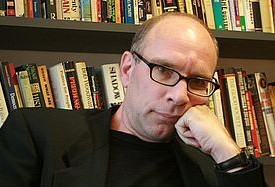Blog Archives
Playing the blame game: on politics and journalism
At the MWF on Friday, as the New News sessions were running hot in the Wheeler Centre, BBC correspondent Nick Bryant, political journalist for the Australian George Megalogenis, commentator and former staffer of Kevin Rudd, Tim Soutphommassane, and Stuart Littlemore, Media Watch presenter between 1989 and 1998, got together to discuss the intersection between journalism and politics.
Bryant posed the question: who is to blame for the infantilisation of politics? Megalogenis for the most part appeared to argue around an answer, apportioning blame everywhere and nowhere. Soutphommassane argued that politicians are not passive victims – a poor actor cannot just blame the script – and in the professionalisation of politics, ‘conviction’ becomes not a determination to make a firmly-held philosophy into reality, but a matter of political marketing. He then went a step further, however, to claim that the public are culpable for continual media focus on the trivial: that if we as a people are not prepared to call politicians out for their kneejerk policies or vapid media stunts, then we get the politicians we deserve.
Perhaps it was to be expected that Littlemore would turn on the journalists, but in the circumstances it wasn’t unwarranted, as neither Megalogenis nor Soutphommassane acknowledged any form of media accountability in shaping political debate. Littlemore didn’t entirely disagree with either of them, but ‘I have difficulty blaming the citizen,’ he said. ‘And I have difficulty leaving the journalist out of it.’ As the discussion continued, it wasn’t hard to see the cycle of blame emerging: journalists abdicating responsibility for the pitiful nature of their political coverage; politicians blaming a relentless and superficial media for the nature of their policies; and the public becoming outraged at both the calibre of politician they have to vote for and the generally useless information they are fed in the guise of ‘political coverage’ by the popular media.
When the issue of asylum seekers came to the fore, Littlemore put Megalogenis on the spot. One cannot divorce the journalist from growing racism and Islamophobia in society, he claimed, and ‘your employer is one of the worst!’ Editorial is not the same as journalism, Megalogenis countered, and at least the Australian is upfront about its agenda when it does editorialise.
Perhaps these comments would have slid away from memory, like a talking point spouted by a politician in an orange vest on the 6pm news, had this session not been followed up by Jay Rosen’s New News keynote. The crux of the problem of political coverage, Rosen claimed, is that journalists identify with the wrong people. They reframe politics as entertainment because it’s cheaper than presenting it as problem-solving or consensus-building. And in positioning politics as a horse-race or a sport, journalists position themselves as ‘insiders’, and this ‘cult of savviness’ becomes fodder for political coverage itself.
 In response to an audience question, Rosen drew attention to the Murdoch media machine – a tool for bullying and intimidation, and wielded by men seeking to influence power and policy. In order for this machine to function in the way it does, he said, a strange culture of denial exists. The people paid to write for it need to believe that they are merely doing honest jobs as journalists, and that there’s no ‘conspiracy’ involved in the broader corporate structure to dominate or control the direction of policy and politics. And of course there isn’t a conspiracy, Rosen said, because it’s an openly recognised fact that this is the case.
In response to an audience question, Rosen drew attention to the Murdoch media machine – a tool for bullying and intimidation, and wielded by men seeking to influence power and policy. In order for this machine to function in the way it does, he said, a strange culture of denial exists. The people paid to write for it need to believe that they are merely doing honest jobs as journalists, and that there’s no ‘conspiracy’ involved in the broader corporate structure to dominate or control the direction of policy and politics. And of course there isn’t a conspiracy, Rosen said, because it’s an openly recognised fact that this is the case.
It would be ‘bizarre and irresponsible’ Rosen claimed on Twitter later, to interpret his speech to mean that the media was to blame for poor government policy. Indeed, as he said on Lateline, ‘Political actors and producers of news are interdependent at this point.’ But this conception of politics as an inside game – this cult of savviness – is ‘an attack on solidarity.’ If journalists are not fulfilling their responsibility of enabling the public to be more active participants in their own democracy by reporting facts and separating spin from spit, then they are failing at their job. Seen in this light, Littlemore’s comment, made only two hours earlier, seems a lot less arbitrary, and a lot more scary: ‘Popular media is an assault on democracy.’
New News: Innovation in Journalism – what might it look like?
The time is ripe for change and innovation in journalism, with the proliferation of new technology, information sourcing devices constantly at punters’ fingertips and widely publicised missteps by media behemoths. David Higgins, News Limited’s innovations editor, Sam Doust, ABC Innovation,’s creative director and Jay Rosen, New York University joined Margaret Simons to discuss their ideas on how to innovate in journalism.
 Where did the idea for this session come from? When writing a story on the future of Fairfax for The Monthly, Simons asked a senior executive how they were going to innovate journalism, the interviewee said ‘What do you mean’? Although the media is changing quickly, the core of the journalistic method hasn’t changed very much since printing press was invented; Simons argued that no other industry can say the core product has stayed so constant.
Where did the idea for this session come from? When writing a story on the future of Fairfax for The Monthly, Simons asked a senior executive how they were going to innovate journalism, the interviewee said ‘What do you mean’? Although the media is changing quickly, the core of the journalistic method hasn’t changed very much since printing press was invented; Simons argued that no other industry can say the core product has stayed so constant.
Is it possible to change the way we tell stories or communicate news? Higgins suggested that it’s possible to vary the presentation of news and reach different audiences through ‘gamification’. During his tenure as website editor for the Sydney Morning Herald and news.com.au, fighting in Sudan was intensifying, yet he ‘couldn’t get people to read these stories no matter how good the journalism was’. MTV, of all outlets, said Higgins, came up with an idea that cut through this – a computer game called Darfur is Dying. The difference between this method of storytelling and how a journalist or foreign correspondent would tell the story was startling, and Higgins stressed that he wasn’t suggesting games as the new face of journalism, but one ‘attempt to get a level of differentiation into journalism – why we’re suffering is there’s so many similar versions of the same stories out there’.
Sam Doust took to the projector to demonstrate some of the new presentation and marketing ideas the ABC is using to showcase its work. Their The Explainer tumblr contains many of these examples. For instance, to complement the Rear Vision radio program on how to get out of Guantanamo Bay, an interactive flash and html animation was created. This was just one way to reach people who might not beading the articles; the Journey through Climate History moving timeline is a visually engaging interface for engaging with the information itself, which, Doust said was of course more important than any visualisation technique.
Jay Rosen agreed with this, saying that innovation doesn’t necessarily involve building new tools or programming machines: ‘The tools I’m interested in are people, ideas, and the will to do things differently’. Rosen called this ‘soft’ innovation – changing the way you do journalism, which often uses new tools but isn’t strictly about that. What kinds of innovations would involve readers working with journalists (‘mutualisation’ in Rosen’s parlance)? Take a look at openfile.ca – anyone who wants to can ‘open a file’; that is, prompt an investigation. Editors then assign a story to a reporter. Stories that come up through this method are five to seven times more visited than those their editors suggested. Another way to do this is covered in Rosen’s blog post, The 100 Percent Solution: decide on what you want to cover, and work out how to cover all of it. How exactly could you do this? Deputise your users in, for example, tweeting comments, scores and images.
Many of the audience members either took this advice to heart or didn’t need it: the #newnews hashtag was getting a thorough workout, with heads bent over smartphones and fingers tapping away on laptops throughout the session.
Blogger’s picks for MWF 2011
I’ve started circling events in the MWF program. Terrifying and all-encompassing though the red pen carnage may seem, there are some events I know I won’t miss.
 Usually my list is fiction-heavy, but thanks to the growing hubbub about digital news and the recent resurgence in interest about the ethics of journalism, New News 2011 has been a focus of my festival planning this year. New News 2011 will bring together media leaders and commentators from all over Australia and the world, including New York University media critic Jay Rosen, chair of the Public Interest Journalism Foundation Margaret Simons, and ABC Managing Director Mark Scott. Rosen’s Big Ideas: Why Political Coverage is Broken promises electrifying analysis of journalism today, and Media Leaders Held to Account offers one intrepid participant the opportunity to share the stage with Mark Scott and Crikey‘s Sophie Black (to be in the running, submit a question at OurSay).
Usually my list is fiction-heavy, but thanks to the growing hubbub about digital news and the recent resurgence in interest about the ethics of journalism, New News 2011 has been a focus of my festival planning this year. New News 2011 will bring together media leaders and commentators from all over Australia and the world, including New York University media critic Jay Rosen, chair of the Public Interest Journalism Foundation Margaret Simons, and ABC Managing Director Mark Scott. Rosen’s Big Ideas: Why Political Coverage is Broken promises electrifying analysis of journalism today, and Media Leaders Held to Account offers one intrepid participant the opportunity to share the stage with Mark Scott and Crikey‘s Sophie Black (to be in the running, submit a question at OurSay).
One fiction writer who has raced up my list of to-sees is Steve Hely, whose How I Became a Famous Novelist is a magnificently titter-inducing work of satire. The novel tells the story of a down-and-out college entrance essay writer who cracks the code of the best-selling literary novel (‘Rule 16: Include plant names’). As well as being a novelist, Hely writes for television programs 30 Rock, The Office and American Dad, and it shows in his mortifyingly acute descriptions (‘The only other customer at the coffee bar…was tearing apart a cranberry-raisin muffin with frantic violence. Crumbs were strewn across her open copy of The Jane Austen Women’s Investigators’ Club.’) Not for reading die-hards who cannot laugh at themselves. Hely is appearing in TV Tales, with Wendy Harmer, Tim Ferguson and many more TV writers; The Morning Read, always a lovely way to ease yourself into festival season; The Comedy of Publishing, and Friday Night Live.
titter-inducing work of satire. The novel tells the story of a down-and-out college entrance essay writer who cracks the code of the best-selling literary novel (‘Rule 16: Include plant names’). As well as being a novelist, Hely writes for television programs 30 Rock, The Office and American Dad, and it shows in his mortifyingly acute descriptions (‘The only other customer at the coffee bar…was tearing apart a cranberry-raisin muffin with frantic violence. Crumbs were strewn across her open copy of The Jane Austen Women’s Investigators’ Club.’) Not for reading die-hards who cannot laugh at themselves. Hely is appearing in TV Tales, with Wendy Harmer, Tim Ferguson and many more TV writers; The Morning Read, always a lovely way to ease yourself into festival season; The Comedy of Publishing, and Friday Night Live.
Finally, the world has been keeping a close eye on the Middle East this year, with a chain of political upheavals generating debate, concern and hope. As Egyptian commentator and journalist Mona Eltahawy has said, ‘Tunisia allowed us to imagine a future beyond our dictators. And everybody was watching Tunisia. And then everybody started watching Egypt and then Bahrain and Yemen and Libya and Syria. So, everybody’s paying attention.’ I’m looking forward to Eltahawy’s analysis in Big Ideas: The Roots of the Egyptian Revolution – From Tahrir Square to Liberation From Dictatorship. You can see Eltahawy commenting on the trial of Hosni Mubarak here, and on the Syrian blogger hoax here.
What are your festival picks?